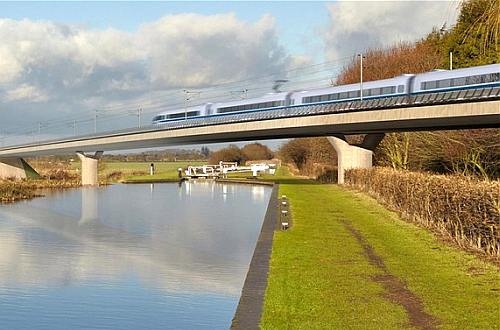The western branch will continue the line from the northern extremity of phase 1, passing east of Stafford and roughly following the route of the West Coast Main Line (WCML) as far as Crewe, where there will be a link to the existing line to allow high-speed services to Liverpool. A triangular junction will be built east of Manchester which will allow services to run east to Manchester Airport and the city centre, and north to join the WCML south of Wigan. High-speed services to Manchester will terminate at a new central station, which will be built alongside the existing Piccadilly station.
From a junction east of Sutton Coldfield, the eastern branch will follow the M42 highway, passing beneath East Midlands Airport in a tunnel before crossing the River Trent to reach a new East Midlands Hub station, which will be built on the Toton freight yard site between Nottingham and Derby. This will be linked to the cities by conventional rail services with a journey time of 12 minutes and 15 minutes respectively. An extension of the Nottingham light rail network from its nearby western terminus at Toton Lane is also being discussed.
Continuing north, the line will closely follow the M1 highway to Sheffield, where another new station will be built at Meadowhall, a location already well-served by conventional rail and light rail. The DfT says the journey time by rail between the new HS2 station and Sheffield Midland will be "as little as five minutes".
The line will then continue east of Barnsley and Wakefield to reach a junction southeast of Leeds, with one branch heading into the city centre to serve a new station at New Lane, a short walk from the existing mainline station, and the other curving east to provide a connection with the East Coast Main Line south of York.
Journey times between Leeds and London will be cut from 2h 12min to 1h 12min, while Manchester – London will be almost halved to 1h 8min. The line will also dramatically reduce journey times between major regional centres. According to DfT, journey times between the city centres of Manchester and Birmingham will fall from 1h 8min to 41 minutes, while Leeds – Birmingham will cut from 1h 58min to 57 minutes. HS2 stations at Leeds, Sheffield, East Midlands and Birmingham will each be separated from the next by journey times of under 20 minutes.
Construction is due to start on the initial 190km phase between London and Birmingham/Lichfield in 2017, and this section is due to open in 2026. Both of the phase 2 branches are due to open by 2032, although the launch of public consultation on phase 2 has been brought forward to this year and Transport Minister Mr Patrick McLoughlin has asked the DfT to look at options to speed up implementation of the project. A Hybrid Bill is due to be submitted to parliament by the end of this year and the final route will be selected by the end of next year.
DfT will also commission a joint study with Transport Scotland to look at how the line will serve Scottish cities and consider the Scottish government's aspirations for high-speed rail.
Plans to build a direct link between the new line and Heathrow Airport appear to be on hold, however pending the conclusions of a report by the Airports Commission on connections to major international airports.
Detailed profile maps for the initial preferred route of phase 2 can be found on the DfT website.

